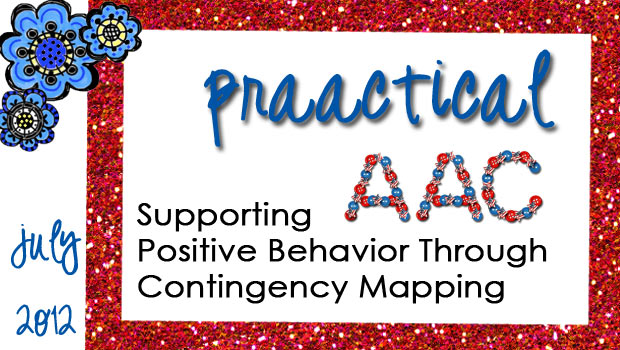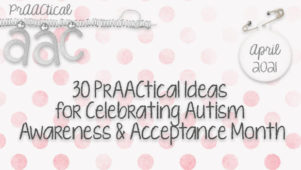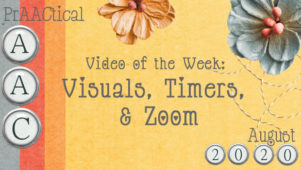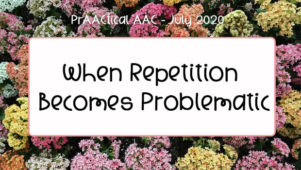Supporting Positive Behavior Through Contingency Mapping

This month we’re focusing on visual supports and strategies to support positive behavior. We’ve talked about transition supports and environmental arrangements. Another way to help therapy sessions run smoothly and keep the focus on learning (rather than managing behavior) is to take proactive steps to make the expectations clear. For most people who are learning AAC, that means making sure there is a visual representation that accompanies the verbal explanation.
–
Many SLPs create a list of rules for expected behavior. In this post, we’ll talk about the research-supported strategy of using contingency maps. Contingency maps are a visual depiction that shows the desired behavior and the outcomes of two divergent paths: one where the learners engage in the desired behavior and the other that shows what happens if they don’t engage in the desired behavior. If you’re familiar  with behavioral approaches, this strategy is right up your alley. The contingency map generally shows the ABCs: antecedent (A), the desired behavior (B), and the consequences (C ). There are two paths: one that shows the desired behavior and consequence for it and the other that shows what happens if the learner engages in the problem behavior. Two paths, two consequences.
with behavioral approaches, this strategy is right up your alley. The contingency map generally shows the ABCs: antecedent (A), the desired behavior (B), and the consequences (C ). There are two paths: one that shows the desired behavior and consequence for it and the other that shows what happens if the learner engages in the problem behavior. Two paths, two consequences.
–
Trina, a 9-year-old girl with soulful eyes and a limber body, taught me the power of contingency maps one summer. Among other things, Trina loved to climb and loved to be barefoot. I wasn’t crazy about her being barefoot, but I could live with it. Climbing, however, was another matter. In a split second, she could hoist herself on top of a table, shelf unit, or cabinet. Scary stuff. (Ever woke up in the night from dreams of a bookcase crashing down onto one of your little ones? You know what I’m talking about.) The climbing thing had to be addressed.
–
For Trina, we used her love of being barefoot to help us manage the climbing and keep her safe.
- Desired outcome: Feet on the floor.
- Consequence for the desired behavior: Get to keep shoes off
- Undesired or problem behavior: Climbing
- Consequence for the undesired behavior: Putting shoes on
Trina’s understanding of language was quite limited, so it took a few repetitions of the contingency map and some tussles over getting shoes on once she had climbed, but within days, she understood. After that, we reviewed the contingency map in the morning and after lunch, and had few additional problems. Trina learned, the other kids were safer, and I slept better. Thanks, Drs. Brown and Mirenda, for your research on this strategy!
–
What we like about contingency maps is that they show the likely outcome for what happens when you follow the expectations and what happens when you don’t. Social thinking and advanced planning doesn’t come easily to some of our AAC learners, so what may be obvious to us (the consequences), may not be something they can foresee. Having a visual representation can make all the difference.
–
Here are some tips on making contingency maps work in your clinical practice.
- Use natural consequences whenever possible. It’s easier to sustain the positive changes when the consequences remain after the training ends. That’s more likely when natural consequences are used.
- Teach the strategy. Use the visual support (the actual contingency map you created) to show the learner what will happen if he/she chooses each path.
- Practice. Go through each path and simulate what happens for each choice.
- Keep the contingency map in a visible location so that you can refer to it throughout the day. Consider keeping a small, portable version of it with you (e.g., hooked to a belt loop) for behaviors that you have to manage immediately
- Give a meaningful rationale for the consequences. If Trina chose to climb, we’d have her put shoes on. Maybe having shoes on would help her feet stay on the floor and keep her safe. That was the story and we stuck to it.
- Consider adding the contingency map to the person’s AAC device. That gives you another way to talk about what will happen (future) and/or what did happen (past).
- Share the news. It’s helpful for everyone to know what strategies you are using. Go over the contingency map when mom comes at the end of the session, or show the aide when you take the student back to the classroom. When your client does well, you can use the map to show what happened and celebrate the success.
–
We love the way that contingency maps fit in with our overall approach of making language visible. Hope you get good results with this prAACtical strategy.
–
Brown, K. & Mirenda, P. (2006). Contingency mapping: Use of a novel visual strategy as an adjunct to functional equivalence training. Journal of Positive Behaviour Interventions,
8 (3), 155-164.
–
Filed under: Strategy of the Month
Tagged With: ASD, behavior, contingency map, developmental disability, intellectual disability, positive behavior support, visual supports
This post was written by Carole Zangari
/contingency_map_bcpbs_presentation.png)





7 Comments
These work very well! Especially the consequences terminology and getting the kids to understand that there can be good consequences as well. 🙂
We’ve found that to be true as well, Jeremy. It’s just another way of building their understanding of a situation, and, like you said, it goes both ways. Thanks for taking the time to comment!!
Hi! My name is Amy Buie. I am the Executive Directive of The Center for Autism Education, a private school for children with Autism who have severe behavior. I have worked in the field for over 25 years and throughout my time with children and adults I have used Consequence Maps. When looking for new ideas, I found your examples of consequence maps on your website.
I would like to let you know that I have written a book and created a website for making Consequence Maps, or as I have always called them, Behavior Maps. I’ve used the strategy for children with problem behavior for many years. My book is written about how I have used consequence maps with children with autism and is now available from AAPC. It’s entitled, Behavior Mapping: A Visual Based Strategy for Teaching Appropriate Behavior to Children with Autism and Related Disorders. It can be purchased on Amazon or http://www.aapcpublishing.net
As I have continued to train teachers throughout the Midwest, it became clear that consequence maps were difficult to make without being a good artist. Therefore, I created a web-based program and it is now available to make Consequence Maps. I have started out with a basic site and have worked with a graphic artist to create images of common appropriate behaviors as well as problem behaviors and common reinforcers.
I’d like to ask that your school district or agency either purchase a subscription or help promote this great tool for teachers. Because you are currently using them, you have a great expertise in how they work. You can begin making behavior maps easily with the program by using the library of pictures or by uploading your own. I would love your feedback so I can make sure it’s just what teachers need. I could use your help with what images work well and what other images you think I need to add.
The website is http://www.behaviormappingmaker.com I’d like for you to be able to be a part of creating a great resource for teachers throughout the United States. I’d also like to share your examples and success stories on the site which will let others know the great things you are doing in your classrooms and district.
Also, if you could pass the information to others who might benefit from using consequence maps– teachers, implementers, or parents, I would really be grateful.
Please let me know if you have any questions.
Thank you so very much!!
Amy Buie, MEd, BCBA, LBA
Executive Director
The Center for Autism Education
Thanks for sharing that information, Amy. I’m sure it will be of interest to many of our prAACtical friends. We will definitely visit your site to check it out. Thanks again for stopping by to alert us to this resource!
I am trying to find out what the age ranges are for using behavior mapping markers. I presently work with children birth to 5 with disabilities. Can this mapping be used at this young age???
Mitzy, I haven’t seen specific age ranges, but I have certainly used them with children in the 4-5-year-old range.
Carole, Thank you, I would like to know if anyone else knows if it can be used under 4 as well. There must be some information regarding what the age ranges are, just haven’t seen anything!!